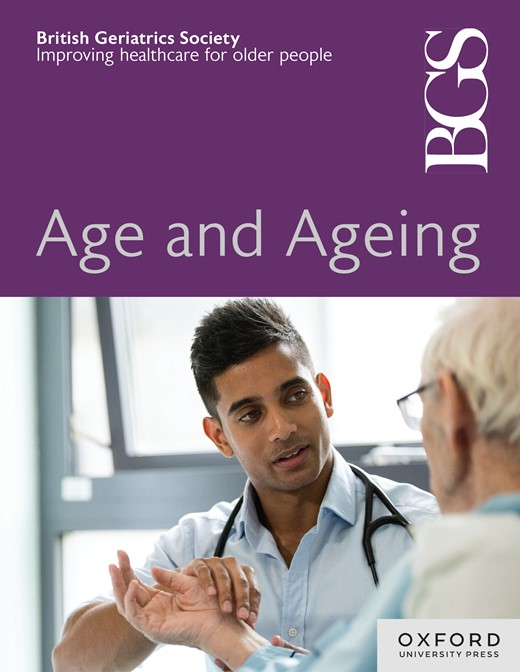Validation of the 4AT for assessing recovery from delirium in older hospital patients
IF 6
2区 医学
Q1 GERIATRICS & GERONTOLOGY
引用次数: 0
Abstract
Background A crucial part of delirium care is assessing for recovery, yet there are no validated methods for this. The 4AT is a widely used delirium assessment tool, but its performance in assessing recovery remains unstudied. This study evaluated the 4AT’s performance in assessing recovery from delirium. Materials and methods In this prospective diagnostic accuracy study, older hospitalised patients (≥70 years) with reference standard delirium on enrolment were assessed 2–4 times over ≤9 days. Paired researchers independently conducted blinded assessments of (i) a reference standard (Diagnostic and Statistical Manual for Mental Disorders, 5th edition), including the Delirium Rating Scale-Revised-98 and neuropsychological tests and (ii) the 4AT (index test, score ≥ 4 positive) plus brief measures of distress and psychotic symptoms. Results A total of 120 people with delirium participated [median age 86.3, range 70–99, 67 (55.8%) female and 55 (45.8%) with dementia]. All of them completed the first two assessments, 103 (85.8%) completed three and 69 (57.5%) four. Reference standard delirium was present in 102/120 (85%), 72/103 (69.9%) and 53/69 (76.8%) cases at assessments two to four, respectively. In Receiver Operating Characteristic analyses, the 4AT’s sensitivity for detecting delirium was 0.95 (confidence interval 0.91–0.99), 0.96 (0.91–1) and 0.94 (0.88–1), and specificity was 0.67 (0.13–1), 0.88 (0.71–1) and 1 (1–1) at assessments two to four. In total 18 (15%) participants recovered from delirium. Distress was common in delirium and decreased with recovery. Conclusion The 4AT maintains diagnostic accuracy on repeated admissions and may effectively assess delirium recovery in acute hospital settings. Fewer patients than expected recovered within 9 days, suggesting more studies on the natural history of delirium in different settings would be informative.4AT评估老年住院患者谵妄恢复的有效性
背景谵妄护理的一个关键部分是评估恢复,但目前还没有有效的方法。4AT是一种广泛使用的谵妄评估工具,但其在评估恢复方面的性能尚未研究。本研究评估了4AT在评估谵妄恢复方面的表现。在这项前瞻性诊断准确性研究中,对入组时伴有参考标准谵妄的老年住院患者(≥70岁)在≤9天内进行2-4次评估。配对研究人员独立进行了盲法评估:(1)参考标准(精神障碍诊断和统计手册,第5版),包括谵妄评定量表-修订-98和神经心理测试;(2)4AT(指数测试,得分≥4阳性)加上简短的痛苦和精神病症状测量。结果共120例谵妄患者参与[中位年龄86.3,范围70 ~ 99岁,女性67例(55.8%),痴呆55例(45.8%)]。全部完成前2次评估,103例(85.8%)完成3次评估,69例(57.5%)完成4次评估。参考标准谵妄分别出现在102/120例(85%)、72/103例(69.9%)和53/69例(76.8%)。在受试者工作特征分析中,4AT检测谵妄的灵敏度为0.95(置信区间0.91-0.99)、0.96(0.91-1)和0.94(0.88 - 1),特异性为0.67(0.13-1)、0.88(0.71-1)和1(1 - 1)。共有18名(15%)参与者从谵妄中恢复。焦虑常见于谵妄,随康复而减少。结论4AT在反复入院时保持诊断准确性,可有效评估急性谵妄恢复情况。在9天内康复的患者比预期的要少,这表明对不同环境下谵妄的自然史进行更多的研究将是有益的。
本文章由计算机程序翻译,如有差异,请以英文原文为准。
求助全文
约1分钟内获得全文
求助全文
来源期刊

Age and ageing
医学-老年医学
CiteScore
9.20
自引率
6.00%
发文量
796
审稿时长
4-8 weeks
期刊介绍:
Age and Ageing is an international journal publishing refereed original articles and commissioned reviews on geriatric medicine and gerontology. Its range includes research on ageing and clinical, epidemiological, and psychological aspects of later life.
 求助内容:
求助内容: 应助结果提醒方式:
应助结果提醒方式:


